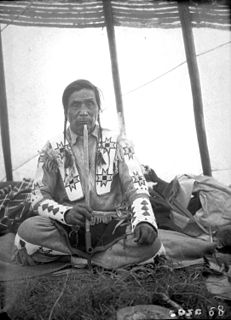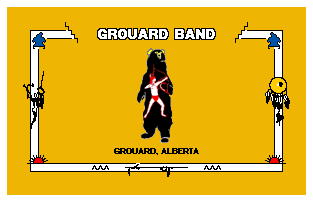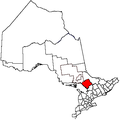The Cree are a North American Indigenous people. They live primarily in Canada, where they form one of that country's largest First Nations.
In Canada, an Indian reserve is specified by the Indian Act as a "tract of land, the legal title to which is vested in Her Majesty, that has been set apart by Her Majesty for the use and benefit of a band."

The Muskoday First Nation is a First Nation band government in Saskatchewan, Canada, composed of Cree and Saulteaux peoples. The First Nation has a registered population of 1,828 people as of September 2014, of which approximately 623 members of the First Nation live on-reserve, and approximately 1204 live off-reserve. Muskoday's territory is located in the aspen parkland biome. It is bordered by the rural municipalities of Birch Hills No. 460 and Prince Albert No. 461.

The Enoch Cree Nation #440 is a First Nations band government in Alberta, Canada. Members of the Nation are of Cree ancestry and speak the Plains Cree dialect of the Cree language group. The band is a signatory of Treaty 6 and is a member of the Confederacy of Treaty Six First Nations. The chief of the Enoch Cree Nation is William (Billy) Morin.
In Canada, an Indian band or band, sometimes referred to as a First Nation band or simply a First Nation, is the basic unit of government for those peoples subject to the Indian Act. Bands are typically small groups of people: the largest in the country, the Six Nations of the Grand River First Nation had 22,294 members in September 2005, and many have a membership below 100 people. Each First Nation is typically represented by a band council chaired by an elected chief, and sometimes also a hereditary chief. As of 2013, there were 614 bands in Canada. Membership in a band is controlled in one of two ways: for most bands, membership is obtained by becoming listed on the Indian Register maintained by the government. As of 2013, there were 253 First Nations which had their own membership criteria, so that not all Status Indians are members of a band.
Waterhen Lake First Nation is a Cree First Nation band government located in northwestern Saskatchewan, Canada. As of October 2018 the total membership of the Waterhen Lake First Nation was 2,053. There were 983 members living on reserve, 2 on Crown Land and 1,068 members living off reserve. The First Nation is a member of the MLTC Program Services, a regional tribal Chiefs' Council. The First Nation is also a signatory to the Adhesion to Treaty 6 in 1921.
The First Nations of New Brunswick, Canada number more than 16,000, mostly Miꞌkmaq and Maliseet (Wolastoqiyik). Although the Passamaquoddy maintain a land claim at Saint Andrews, New Brunswick and historically occurred in New Brunswick, they have no reserves in the province, and have no official status in Canada.

The Red Pheasant Cree Nation is a Plains Cree First Nations band government in the Canadian province of Saskatchewan. The band's sole reserve, Red Pheasant 108, is 33 km (21 mi) south of North Battleford.
Fishing Lake First Nation is a First Nation of the Saulteaux branch of the Ojibwe nation. The band can trace their origins to central Canada, and were pushed westward to avoid encroachment by European settlers. The First Nation was originally part of the Yellow-quill Saulteaux Band, a Treaty Band named after a Treaty 4 signatory Chief Ošāwaškokwanēpi, whose name means "Green/Blue-quill." However, due to "š" merging with "s" in Nakawēmowin, this led to a mistranslation of his name as "Yellow-quill"—"yellow" being osāw-, while "green/blue" being ošāwaško-. The band was given three reserves, at Fishing and Nut Lakes and Kinistino, Saskatchewan. The Fishing Lake Indian Reserve 89 was approximately 22,850 acres (92.5 km2). Soon after the death of Chief Ošāwaškokwanēpi, the Band divided into three groups, the Fishing Lake First Nation, the Yellow Quill First Nation, and the Kinistin Saulteaux Nation

The Woodland Cree First Nation is a First Nation in Alberta, Canada adjacent to the Cadotte Lake in Northern Sunrise County northeast of the Town of Peace River. The hamlet of Cadotte Lake is located within the reserve.

The Samson Cree Nation, also known as the Samson First Nation, is one of four band governments in the area of Maskwacis, Alberta, Canada.

Star Blanket Cree Nation is a First Nations band government in Saskatchewan, Canada. Its reserves are in the Fort Qu'Appelle area. The Star Blanket Cree Nation is one of the bands covered by Treaty 4.

The Kapawe'no First Nation is a band government in Alberta, Canada. It is headquartered at Grouard, Alberta, which is near High Prairie.

Whitecap Dakota First Nation is a Dakota First Nations band government whose reserve is located 26 km (16 mi) south of Saskatoon, Saskatchewan, Canada. Governing the Whitecap Indian Reserve No. 94, historically referred to as the Moose Woods Sioux Reserve, it is bordered by the Rural Municipality of Dundurn No. 314 and located along Highway 219 between the South Saskatchewan River and CFAD Dundurn.

Peepeekisis Cree Nation is a Cree First Nation in southern Saskatchewan, Canada. Its reserves include Peepeekisis 81; Treaty Four Reserve Grounds 77, which is shared with 32 other bands; and Peepeekisis First Nation, which is located 19 km (12 mi) east of Balcarres, Saskatchewan, on Highway 10.

Beardy's and Okemasis' Cree Nation is a Cree First Nations band government in Saskatchewan, Canada. Their reserves include:










